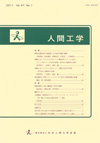
- |<
- <
- 1
- >
- >|
-
Taro MATSUKI2023Volume 59Issue 3 Pages 99-102
Published: June 15, 2023
Released on J-STAGE: June 21, 2023
JOURNAL FREE ACCESSDownload PDF (322K)
-
Ryota MURANO, Takeshi SATO, Takayuki TOMONO, Macky KATO2023Volume 59Issue 3 Pages 103-112
Published: June 15, 2023
Released on J-STAGE: June 21, 2023
JOURNAL FREE ACCESSThe present study aimed to clarify the effects of “shoe-lacing tightness” on gait. Participants included nine males (22.8±1.2 years) and nine females (21.9±1.8 years), who walked at their normal pace and a fast pace under two shoe-lacing conditions, which differed in lacing tightness (fit and loose). Walking speed, step length, and step width were measured with a walking posture measurement system, which includes Kinect v2. Gait cycle time, trunk movement, and Harmonic Ratio (HR) were measured and calculated with another system, which uses two inertial sensors placed on the thoracic vertebrae (Th6) and sacrum (S2) of each participant. Two-way repeated-measures MANOVA was conducted for all analysis items, and significant differences were found in the walking task and the shoe-lacing condition. Walking speed, vertical movement of S2, and vertical HR of Th6 under loose-lacing conditions were significantly smaller than those under fit-lacing conditions. Mediolateral movement of Th6 and anteroposterior movement of S2 under loose-lacing conditions were significantly larger than those under fit-lacing conditions. This study clarified that loose-lacing conditions affects gait.
View full abstractDownload PDF (1062K) -
Kimihiro YAMANAKA, Kenji KOBAYASHI2023Volume 59Issue 3 Pages 113-122
Published: June 15, 2023
Released on J-STAGE: June 21, 2023
JOURNAL FREE ACCESSThere are several studies that discriminant analysis and machine learning using parameters related to eye movements and head movements apply to estimate the driver’s mental workload while driving. However, all of the eye movement measuring devices used in these experiments have extremely high time resolution, which is not desirable in terms of cost when developing a system in consideration of practical use. Therefore, the purpose of this experiment was to clarify the minimum value of data measurement sampling that enables extraction of eye movement parameters that can evaluate the difference in mental workload due to the driver’s N-back task. Therefore, we investigated the relation between the estimation accuracy of the driver’s mental workload and the sampling rate when measuring eye movements. As a result, it was shown that the possibility of estimating the driver’s mental workload using eye movement parameters even when the eye movement sampling rate is low.
View full abstractDownload PDF (942K)
-
Testing of Shoulder Joint Movement in Three DimensionsTakuto ITO, Kotaro SIMIZU, Yusaku TAKAMURA, Yuya OHASHI, Kenta TAKEDA, ...2023Volume 59Issue 3 Pages 123-130
Published: June 15, 2023
Released on J-STAGE: June 21, 2023
JOURNAL FREE ACCESSThis study aimed to confirm the accuracy of different modalities of motion analysis techniques for upper limb movements, and then clarify advantages and disadvantages of each potential technologies. The optical motion capture system (Mac3D), depth-based pose estimation (Azure Kinect), and RGB-based pose estimation (MeTRAbs), were chosen for the accuracy comparison. Based on the data obtained from a healthy participant by performing the following movements: (1) shoulder abduction, (2) shoulder flexion, and (3) shoulder horizontal flexion. The joint angles were calculated using the joint position coordinates obtained from each measurement. The result indicated that Azure Kinect demonstrated almost identical value with those of Mac3D, but the error due to difference of pose estimation needs to be considered. MeTRAbs demonstrated enough accuracy in frontal and sagittal plane. In addition, we confirmed that the shoulder abduction as a compensatory movement observed in patient with spinal cord injury could be evaluated by MeTRAbs. Based on these results, MeTRAbs can be regarded as a sufficient accuracy in horizontal plane, which can be used for clinical evaluation in the range of 0 to 90 degrees.
View full abstractDownload PDF (529K)
- |<
- <
- 1
- >
- >|